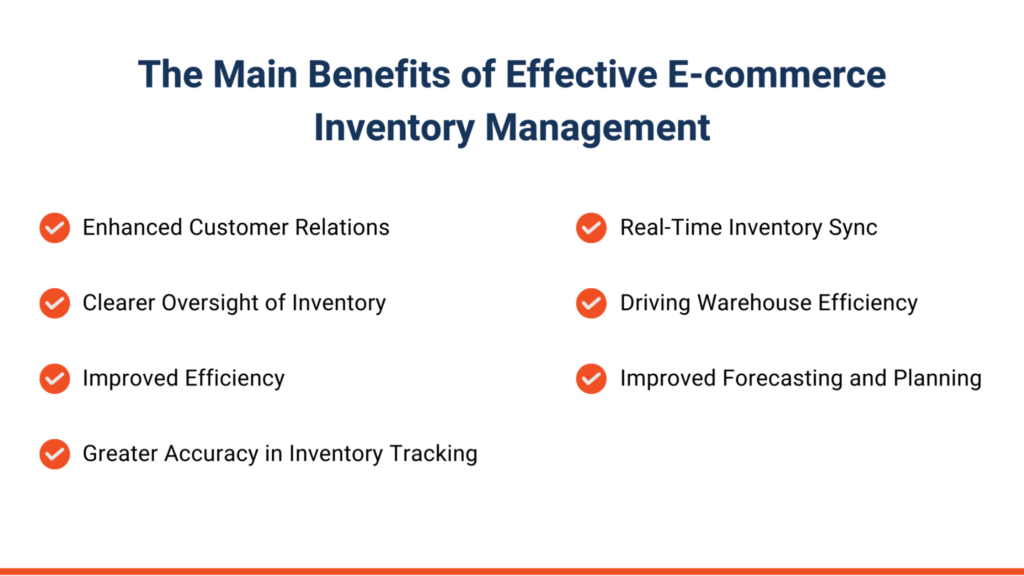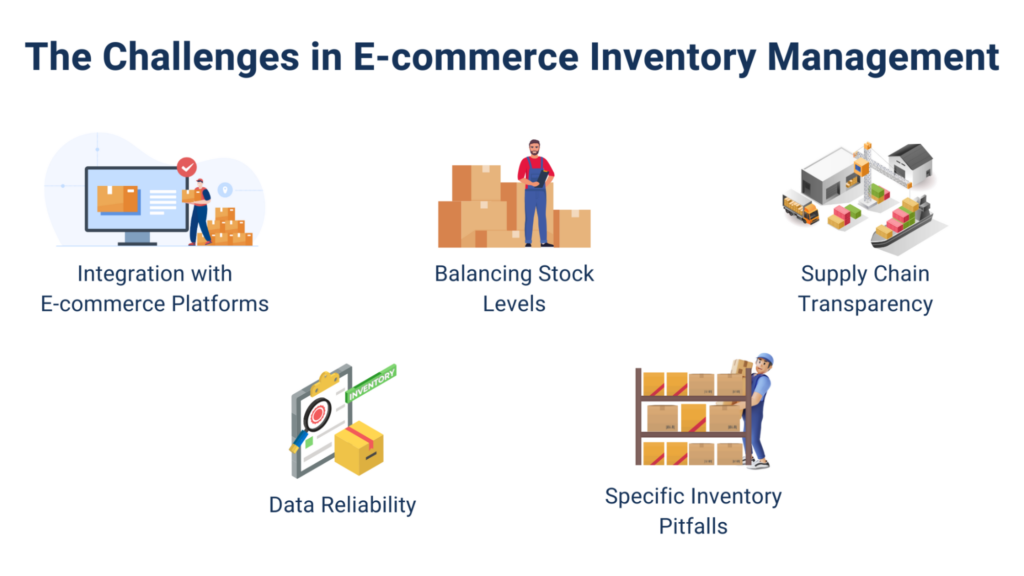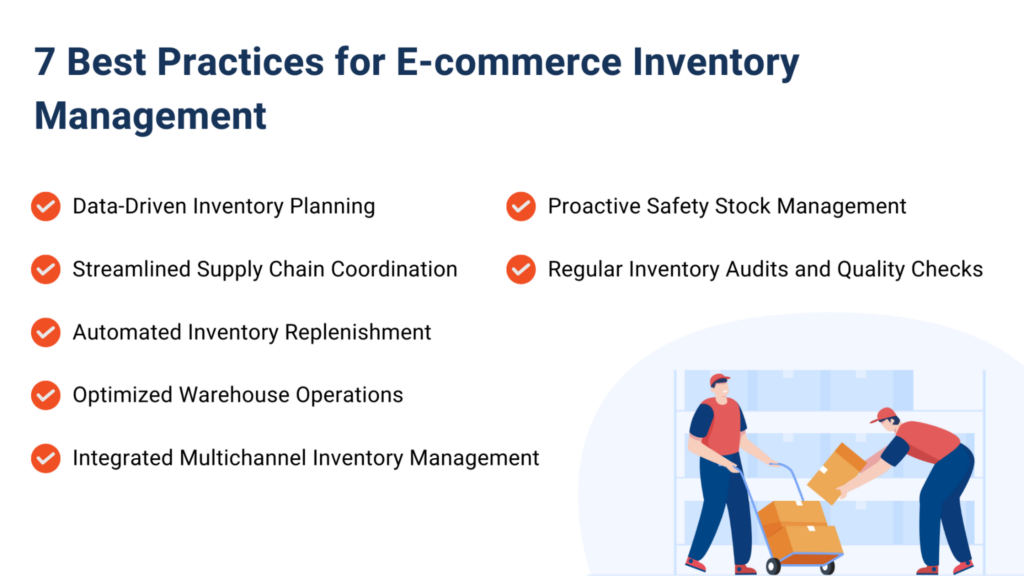Managing inventory effectively is crucial for e-commerce success. With around 59% of the global population now using the internet and forecasts indicating that nearly 95% of all purchases will be made online by 2040, efficient inventory management is more critical than ever.
E-commerce fulfillment is a complex process that covers everything from when a customer places an order to when they receive it. This includes managing orders, handling inventory, packing, logistics, and processing returns, each requiring careful handling and accuracy.
E-commerce retailers, especially those with a wide range of products, face the challenge of keeping track of their inventory. With the complexities of the global supply chain and the constant flow of products from abroad, managing inventory is not only complicated but also vital for the success of an online business.
This blog aims to simplify and explain e-commerce inventory management. We will cover best practices and strategies to manage an online retail business effectively.
What is E-commerce Inventory Management?
E-commerce inventory management is a crucial process in online retail that involves overseeing and controlling the order, storage, and use of products sold online.
Its effective implementation is critical to enhancing efficiency and reducing operational costs in a globally connected marketplace. This process includes :
- Track items in your warehouse or through a third-party logistics fulfillment center (3PL).
- Managing inventory with contract manufacturers or consigned inventory with other businesses.
- Monitoring products sold via dropshipping and multichannel selling strategies.
By optimizing your e-commerce inventory management, you gain better logistics and analytics insights, enabling you to maintain ideal stock levels and make accurate inventory demand predictions.
The Main Benefits of Effective E-commerce Inventory Management

- Enhanced Customer Relations: Optimized e-commerce inventory management prevents delays and long lead times, ensuring customer satisfaction and fostering repeat business. It’s crucial for customer retention, which is more cost-effective than acquiring new customers.
- Clearer Oversight of Inventory: It provides visibility into when to restock items and identify less profitable products, helping manage different types of inventory such as raw materials, finished goods, work-in-progress (WIP), and third-party stored inventory.
- Improved Efficiency: It influences day-to-day operations and long-term business viability by:
- Streamlining supply chain dynamics.
- Enhancing demand forecasting.
- Adopting lean inventory practices.
- Optimizing order fulfillment and logistics.
- Facilitating informed financial planning and analysis.
- Greater Accuracy in Inventory Tracking: E-commerce inventory management software maintains real-time inventory visibility across multiple sales channels, reducing risks associated with overselling or underselling.
- Real-Time Inventory Sync: Automates inventory updates to e-commerce platforms, ensuring efficient multichannel management from a single inventory pool.
- Driving Warehouse Efficiency: Improves accuracy in order processing, picking, packing, and organizing inventory efficiently within the warehouse.
- Improved Forecasting and Planning: Offers insights into sales patterns and customer behavior, improving the accuracy of demand forecasting and inventory optimization.
By focusing on these aspects, e-commerce businesses can significantly improve their operational efficiency, customer satisfaction, and profitability.
The Challenges in E-commerce Inventory Management

1. Integration with E-commerce Platforms
Many platforms lack advanced inventory tracking. An external system is necessary to prevent time wastage, lost inventory, and errors in labor and accounting.
2. Balancing Stock Levels
Misestimating inventory needs leads to overstocking or understocking, affecting carrying costs, profit margins, and the ability to meet demand.
3. Supply Chain Transparency
Poor communication among suppliers, warehouses, and retailers can create significant operational issues. Transparent processes are key to fulfilling commitments and smooth operations.
4. Data Reliability
Dependable data on inventory movements and sales patterns is essential for strategic decision-making. Inaccurate data hinders growth and profitability.
5. Specific Inventory Pitfalls
- Overstocking: Financial burdens from unsold stock, increased storage costs, and challenges in selling outdated products.
- Understocking and Stockouts: These issues can result in lost sales, diminished customer loyalty, and revenue losses.
- Multiple Warehouse Management: Difficulties include maintaining accurate inventory counts, managing stock transfers, and meeting diverse compliance requirements across locations.
Addressing these challenges is imperative for improving operational efficiency and customer satisfaction in the competitive e-commerce landscape.
7 Best Practices for E-commerce Inventory Management

Inventory typically passes through three primary stages in a warehouse environment:
- Inbound Process: This phase involves procuring goods from suppliers.
- In-House Management: This stage encompasses receiving, unboxing, organizing, and storing the inventory.
- Outbound Logistics: The final stage includes selecting, packaging, and dispatching the goods to the customer.
Each of these stages offers unique chances to optimize the management and monitoring of inventory.
Here, we outline seven best practices vital for enhancing e-commerce inventory management in online retail:
1. Data-Driven Inventory Planning
In e-commerce, understanding and predicting customer demand is crucial. Utilizing robust inventory management software allows for analyzing sales velocity and seasonal trends.
This data-driven approach enables businesses to accurately forecast demand, ensuring the right stock quantity is ordered at the right time. Due to rapidly changing trends, this becomes even more critical for industries like fashion or cosmetics.
- Sales Velocity Analysis involves evaluating the rate at which items are sold to effectively adjust inventory levels. By understanding how quickly products are moving off the shelves, businesses can fine-tune their inventory to align with current sales trends, ensuring they have enough stock to meet demand without overstocking.
- Seasonal Trend Tracking: This practice identifies the seasonal variations in customer demand to adequately prepare inventory for peak periods. By recognizing these patterns, businesses can proactively stock up for high-demand periods and scale down during slower seasons, optimizing their inventory throughout the year.
- Demand Forecasting: Utilizing historical sales data and predictive analytics, businesses can project future sales, particularly vital in dynamic markets like fashion or cosmetics. This forecasting allows companies to anticipate changes in customer preferences and market trends, ensuring they are always equipped with the right products at the right time.
- Responsive Reordering: This entails modifying order quantities based on current data to balance having too much or too little stock. By responding quickly to changes in inventory levels, businesses can maintain an optimal stock level, reducing the risks of overstocking and understocking.
2. Streamlined Supply Chain Coordination
A well-managed supply chain is the backbone of successful e-commerce operations. Monitoring key performance indicators (KPIs) like product quality and vendor reliability, as practiced by Macmillan, ensures the timely and efficient movement of goods from suppliers to warehouses.
This approach helps identify and resolve supply chain bottlenecks, enhancing overall efficiency.
- Vendor Performance Monitoring: Regular evaluation of suppliers is crucial to ensure their reliability and the quality of their products. By continuously assessing vendor performance, businesses can guarantee the consistent quality and timely delivery of inventory, which is crucial for maintaining smooth operations.
- KPI Tracking: Monitoring key performance indicators, such as delivery times, order accuracy, and product quality, helps maintain a high standard in the supply chain. Keeping a close eye on these metrics allows businesses to quickly identify and address issues, ensuring the supply chain operates efficiently and effectively.
- Bottleneck Identification: Proactively identifying and resolving bottlenecks in the supply chain is critical. By swiftly pinpointing areas causing delays or inefficiencies, businesses can implement corrective measures to streamline processes and enhance overall supply chain performance.
- Supplier Relationship Management: Establishing and nurturing strong supplier relationships is key for reliable and efficient supply chain operations. By building a solid partnership, businesses can work collaboratively with suppliers to optimize supply chain processes, negotiate better terms, and ensure a steady and dependable inventory flow.
3. Automated Inventory Replenishment
Automation in inventory management is crucial for maintaining optimal stock levels. Automated alerts or reordering systems prevent stockouts and overstocking, ensuring inventory levels align with current demand. Real-time tracking and predictive analytics further streamline this process.
- Threshold Alerts: Automated alerts can be set up to notify management when stock levels fall below a predetermined threshold. This system ensures the business is immediately aware of low stock levels, allowing for timely restocking and preventing potential stockouts.
- Automatic Reordering: By implementing systems that automatically trigger inventory replenishment based on current stock levels, businesses can maintain a consistent supply of products. This automation streamlines the reordering process, reducing the need for manual intervention and minimizing the risk of human error.
- Real-time Inventory Updates: It is essential to keep inventory records constantly updated with every transaction, whether a sale, a return, or a receipt of new stock. This practice of real-time inventory tracking provides an accurate and up-to-date view of stock levels, enhancing decision-making and operational efficiency.
- Predictive Analysis: Advanced forecasting tools enable businesses to anticipate future inventory needs based on historical sales data, trends, and market analysis. Predictive analysis helps make informed decisions about stock levels, ensuring the business is well-prepared to meet customer demand without overstocking.
4. Optimized Warehouse Operations
Much like Macmillan, an efficient warehouse layout and operations system significantly boosts inventory management. Proper organization of the warehouse space and the strategic placement of items facilitate the smooth and quick movement of goods.
Implementing technologies like barcode scanning and warehouse management systems enhances the precision and speed of inventory handling.
- Strategic Layout: Planning involves designing the warehouse space to ensure efficient movement and accessibility. An optimized layout is crucial for streamlining operations, as it minimizes the time and effort required to move goods within the facility.
- Item Placement Strategy: High-demand items are strategically positioned for quick access. This method ensures that the most frequently ordered products are easily reachable, reducing the time spent picking and packing and speeding up the overall order fulfillment process.
- Technology Integration: Adopting technology like barcode scanners and warehouse management systems is essential for real-time inventory tracking. This integration allows for accurate monitoring of stock levels and movements, enhancing the efficiency and accuracy of warehouse operations.
- Workflow Optimization: Streamlining the picking, packing, and shipping processes is critical for maximum operational efficiency. Optimizing these workflows leads to quicker order processing times and increased customer satisfaction due to faster delivery times.
5. Integrated Multichannel Inventory Management
Maintaining a centralized inventory system is crucial for businesses operating on multiple sales channels. Integrating inventory data from various channels into a single system ensures accurate tracking and availability across all platforms. This approach is particularly beneficial for businesses managing inventory across locations or warehouses.
- Centralized Data Hub: Businesses can maintain a unified view of their stock by consolidating inventory data from various sales channels into a single system. This centralized approach simplifies inventory management across multiple platforms.
- Cross-Channel Visibility: Ensuring that inventory is visible across all sales channels, including online and physical stores, allows for more coherent and efficient inventory management. It ensures consistency in stock information irrespective of where the sale is made.
- Inventory Synchronization: Synchronizing inventory levels in real-time across all channels is vital. This synchronization prevents overselling and stockouts, ensuring a smooth customer experience across all sales platforms.
- Multi-Location Management: Effectively coordinating inventory across different warehouses or storage locations is key for businesses with multiple storage sites. This coordination ensures consistent inventory levels and efficient distribution of stock.
6. Proactive Safety Stock Management
Maintaining an optimal safety stock level is key to buffering against supply chain uncertainties. Macmillan’s strategy of calculating safety stock based on factors like lead time and daily usage helps in continuous order fulfillment, even during unexpected demand surges or supply chain disruptions.
- Safety Stock Calculation: Calculating the optimal safety stock level based on factors like lead times and daily sales helps maintain a buffer against unforeseen supply chain disruptions or sudden spikes in demand.
- Dynamic Adjustments: Regularly adjusting safety stock levels to align with changing demand and supply conditions helps maintain the right inventory balance.
- Buffer Against Uncertainty: Utilizing safety stock as a protective buffer helps in continuous order fulfillment, even during supply chain uncertainty or unexpected demand increases.
- Inventory Balance: Maintaining a balanced inventory to meet customer needs without leading to overstocking is essential. This balance ensures optimal stock availability without incurring unnecessary holding costs.
7. Regular Inventory Audits and Quality Checks
Regular stock audits and quality checks are essential for identifying discrepancies and ensuring inventory accuracy. This practice helps maintain the integrity of stock levels and identify and address potential issues with inventory quality.
- Scheduled Audits: Conducting regular physical inventory counts helps verify the accuracy of inventory records. These audits are crucial for identifying and rectifying discrepancies between physical stock and system records.
- Quality Control Inspections: Regular inspections of incoming and existing stock ensure quality and accuracy. This step is vital to maintain high product quality standards and prevent the sale of defective goods.
- Discrepancy Resolution: Identifying and resolving differences between physical inventory and inventory records is essential. Addressing these discrepancies quickly helps maintain inventory accuracy and reliability.
- Continuous Improvement: Utilizing the insights gained from inventory audits and quality checks aids in continually refining inventory management processes. This practice leads to reduced errors and improved efficiency over time.
Implementing these best practices can significantly enhance the efficiency and reliability of e-commerce inventory management. For a logistics provider like Macmillan, these strategies are not just recommendations but essential to operational excellence, ensuring they remain at the forefront of e-commerce logistics solutions.
Elevate Your E-commerce Fulfillment Strategy with MacMillan

MacMillan stands out for its comprehensive supply chain management and advanced reverse logistics, enhancing customer trust and satisfaction through expert handling of products from arrival to delivery.
Understanding the uniqueness of each e-commerce business, we offer customized solutions tailored to specific challenges and market dynamics. With a focus on sustainability and trust, MacMillan has established a reliable network, positioning itself as a dependable partner in the e-commerce industry.
Elevate your e-commerce fulfillment with MacMillan, where efficient logistics meet a commitment to trust, reliability, and customer satisfaction.